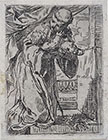Pesaro 1612 - Verona 1648
Cantarini began his artistic training quite young, probably 1623-1625, in Pesaro, at the studio of Giovanni Giacomo Pandolfi, a painter of religious works who combined the local naturalism with the mannerist style of the late sixteenth century. After a brief trip to Venice, Cantarini moved to the shop of Claudio Ridolfi, a student of Paolo Veronese. From Ridolfi he received training in the Venetian manner, as well as a deep appreciation for the art of Federico Barocci, with whom Ridolfi had worked in Urbino. In about 1629 Ridolfi left Pesaro, forcing Cantarini to continue his studies on his own. In addition to prints by the Carracci, the young artist turned his attention increasingly to Barrocci and also to the caravaggesque art of Orazio Gentileschi, who executed several works in the Marches during the 1610s, and of Giovan Francesco Guerrieri, from nearby Fossombrone. The most significant event of Cantarini's youth was the arrival, probably in 1632, of Guido Reni's 'Madonna and Child with Saints Thomas and Jerome' in Pesaro Cathedral. The young artist quickly assimilated Guido's style and soon received important commissions. At this point Cantarini wanted to go to Bologna to Guido Reni's studio to perfect himself with the master.
Upon his arrival in Bologna, probably in 1634 or 1635, Cantarini presented himself in Guido's studio as a painter of little training. His abilities soon became evident. Guido recognized that Cantarini was already a fully formed painter, and made the young man his most trusted pupil, securing him many commissions. Eventually, however, Cantarini's infamous pride and unbridled tongue came to the fore and alienated the master and the entire studio. The decisive break came in 1637 when Cantarini publicly repudiated Guido's relatively minor criticism of his 'Transfiguration' for the Barberini church at Fortezza Urbana. From this point on, Cantarini's relations with his patrons also deteriorated rapidly, to the point where his commissions fell off almost entirely.
In 1639 Cantarini is documented at his sister's wedding in Pesaro. It must have been shortly thereafter, in 1640 or 1641, that he made a brief trip to Rome. Following Guido's death in 1642, our artist returned to Bologna, where he maintained a successful studio until his death in 1648 following a stay in Mantua.
In the field of print making, Cantarini left forty etchings of own invention or derived from subjects of Guido Reni. They are masterpieces of graphic art executed with a light, airy and careful light value.
